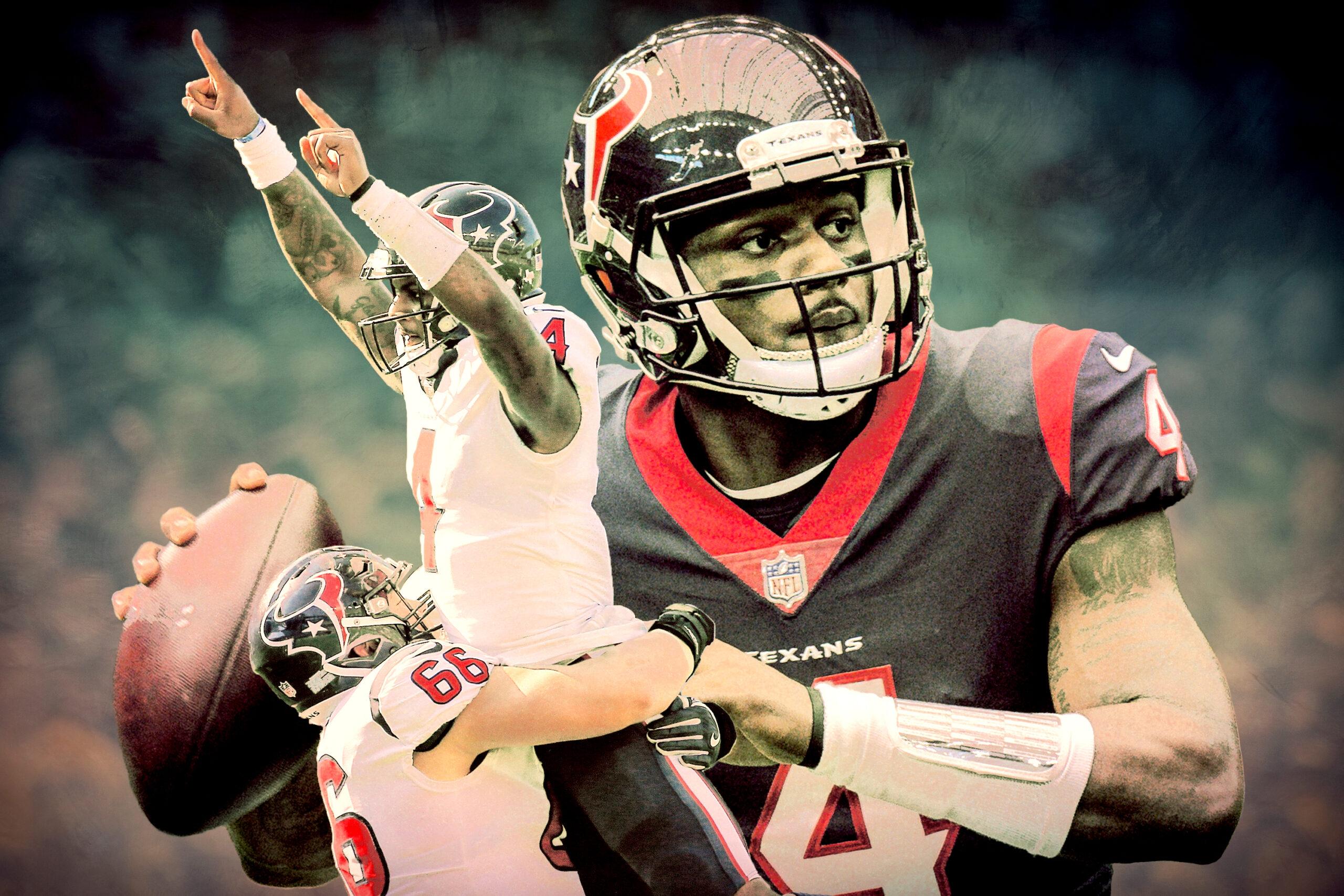
There’s still a lot of season left, but it sure looks like Texans rookie Deshaun Watson is going to give Dak Prescott a run for his money in the Most Impressive Performance by a Rookie Quarterback Ever category. Prescott looked like a 10-year veteran as he picked apart defenses for the Cowboys last year, throwing 23 touchdowns and just four picks while adding six rushing scores in his superlative first-year campaign. Watson’s explosive start has been a statistical wonder in its own right: The first-rounder out of Clemson leads the league in Total QBR (85.5), is seventh in passer rating (100.7), has already thrown 12 touchdowns (second only to Aaron Rodgers), and with a pair of rushing scores, his 14 total touchdowns is the most ever for a rookie quarterback through his team’s first five games.
Much like Prescott, Watson wasn’t supposed to be a starter in his first year. While his impressive training camp and preseason made an impression on head coach Bill O’Brien, Houston’s objective was for the rookie to watch and learn behind incumbent Tom Savage as they developed their new franchise player into a pro passer. That plan lasted for 30 minutes of game time. After just two quarters of disastrous play by Savage in the team’s opener, the Texans let their rookie take over. Instead of sitting behind a veteran for a year to learn the ropes, Watson was thrust into the starting role—and after four and a half games, he has already demonstrated plenty of the playmaking talent he showed off at Clemson, quickly establishing himself as a leader for Houston, which has started the year 2-3.
With two of their top pass rushers in J.J. Watt and Whitney Mercilus lost for the year to injury, though, a team whose fierce defense has dragged the team into the postseason the past two years is likely going to need the offense to do the heavy lifting from here on out. That drop-off defensively should lead to higher-scoring games, and that could make it tough for the Texans to hide or protect Watson in their scheme. The rookie doesn’t have an elite offensive line or dominant rushing attack to lean on, so instead of a conservative, ball-control approach, Houston may need to air things out—and hope their rookie signal-caller can keep playing like the gunslinger we’ve seen the last few weeks.
So far, Watson has looked up to that task: In the team’s narrow loss to the defending Super Bowl champion Patriots in Week 3, Watson dazzled, putting Houston in position late in the game to beat New England, but the defense faltered. Tom Brady did what he does, leading his offense downfield to score the go-ahead, game-winning touchdown with 29 seconds to go. The next week, the rookie scored five touchdowns (four through the air, one on the ground) in Houston’s blowout win over the Titans, and last Sunday, Watson threw another five touchdowns in a losing effort against the Chiefs, the NFL’s best team. Each week, O’Brien has put more and more on the rookie’s plate, as Houston’s situation-neutral pass rate (the percentage of plays in which a team passes when the game is within one score) has steadily increased to a high of 63.6 percent last week, which ranked 11th. O’Brien is trusting his rookie quarterback to execute the passing game, and all Houston’s done since Watson officially took over as starter in Week 2 is lead the NFL in scoring (34.3 points per game).
A big part of Watson’s success has been O’Brien’s willingness to adjust his scheme to fit his quarterback’s strengths. The Texans employ a bevy of spread-offense-style concepts, including plenty of shotgun snaps, a preponderance of pre-snap motion in the backfield (sweep-motion, end-around motion, swaps, etc), and an arsenal of option-style runs—all meant to confuse the defense, create easy reads and throws, and get yards out of the quarterback on the ground. As I wrote about on Wednesday, these types of plays give Houston a numbers advantage on offense, which they’ve exploited with a ton of success.
Watson has run a handful of option-pitch plays, where he can toss the ball outside or keep it himself based on what the defense does. Against the Chiefs, he held on to the ball and got upfield, gaining yards before diving safely to the ground.
Against the Titans, he pitched the ball to his outside option on a pair of plays; one (to Lamar Miller) got them into the end zone, the other (to Bruce Ellington) a nice pickup.
Houston has even used Watson on Cam Newton–style keeper runs—like this designed quarterback draw against Tennessee that picked up a first down.
Watson’s mobility has come into play in the passing game as well. When the scheme design fails, the offense breaks down, and no one looks open downfield, Watson has shown the ability to keep plays alive with elusiveness and cunning. We saw that against the Bengals in Week 2, and last week against the Chiefs he dodged and weaved through Kansas City’s pass rush on a third-and-8 early in the fourth quarter before taking off downfield to pick up a first down on his own.
He did something similar against the Patriots in Week 3, when he pulled off a Houdiniesque escape act in the face of an onslaught of New England defenders, finally getting outside to find running back D’Onta Foreman in the flats for a big gain.

But what Watson can do with his legs—whether it’s in the read-option game, on keepers, or on sprint-outs or bootlegs outside the pocket—is just a bonus, because he’s been incredibly impressive throwing the ball from the pocket, too, both from under center or the shotgun. Watson has thrived in the play-action passing game in particular: On plays that include a run fake, he’s completed 67.4 percent of his passes at 8.8 yards per attempt with a league-high six touchdowns and just one pick on those plays, registering a 124.7 passer rating (fifth) per Pro Football Focus. (Compared with a respectable 87.7 passer rating, with six touchdowns and three interceptions at 6.8 yards per attempt, on non-play-action plays.) It’s no wonder, then, why the Texans run play-action the fourth most often (26.9 percent) leaguewide; Watson has done an excellent job using the threat of a handoff to move defenders and drop passes in behind the defense.
Against the Chiefs, the play-action fake, along with the end-around motion from Ellington, lured the defense forward and to the left, while speedy receiver Will Fuller ran a route to the right. Watson avoided the rush (switching the ball to his left hand momentarily to avoid a strip), stepped up, reset his feet, and delivered a dart downfield for the score.
Against the Titans, a play-action fake helped Watson throw another touchdown. As he put the ball into running back Lamar Miller’s belly on a fake handoff, it enticed Tennessee safety Kevin Byard forward a few steps. All Watson had to do from there was read Byard; when he saw that the fake worked, receiver DeAndre Hopkins snuck in behind where Byard should’ve been, and Watson hit him on the slant for the touchdown.
Play-action passes are not the only thing that can move a defender, though, and Watson has already demonstrated a veteran-like ability to manipulate safeties with his eyes. We saw this in action against the Patriots: Late in the first quarter, O’Brien dialed up a shot at the end zone from the New England 29-yard line.
To create the time his receivers needed to get downfield, he called a max-protect scheme, where seven players (five linemen, a tight end, and the running back) stayed in to pass-block for Watson. When the Patriots rushed four, it left seven defenders in coverage against just three receivers downfield. That meant that for the play to work, Watson had to use his eyes to create a one-on-one situation for his receiver down the field. At the snap, he looked left toward Hopkins, who was running a go route down the sideline. That long, deliberate stare-down got the deep safety, Devin McCourty, to take a few steps toward Hopkins and vacate the middle of the field. That was all Watson needed to see; he reset and threw down the hashes to Ellington, who had gotten a step on his route out of the slot. Touchdown.
Watson did the same thing against the Titans the next week. This time, he looked to Hopkins on his right on the snap, which moved the deep-middle safety out of the way. Watson stepped up, avoided the rush, and threw a bomb to the left into single coverage. Ellington reeled it in for a big gain.
Watson’s tape is littered with “veteran” throws like these, from his back-shoulder touchdown fade to Fuller against Tennessee, or his gem to Hopkins against Kansas City, where he threaded the needle to hit his top wideout in the back of the end zone. He’s also been nearly perfect inside the 10-yard line, too, with eight pass attempts going for six touchdowns and no picks.
But there are plenty of rookie mistakes thrown in, too. Two of Watson’s interceptions (this one against the Patriots, and another against the Titans) have been on the seriously ugly side, both unnecessary throws that he made off balance and into heavy coverage.
He has battled inconsistent accuracy downfield as well, something that scouts knocked him for in the pre-draft process. Watson has been one of the most aggressive deep-ball throwers in the NFL so far—a league-high 19.3 percent of his passes have gone 20-plus yards downfield, per Pro Football Focus—and he’s tied for the league lead with four deep touchdown passes. But he’s also thrown a league-high three picks on those throws, and completed just 10 of those 28 attempts, for a 35.7 percent accuracy percentage (20th) and a 76.2 passer rating (20th). The rookie still has to dial in his precision downfield, and it’s important to remember that as with any first-year player, there’s bound to be some pretty major ups and downs as he develops.
Overall, though, Watson’s performance has been nothing short of exhilarating. It’s not just that he’s surviving the burdensome rookie learning curve—he looks like he’s having fun out there, too. He throws downfield. He gets outside the pocket and makes plays. And he’s done that despite facing pressure on a league-high 46.2 percent of his dropbacks, worse even than what Russell Wilson has faced behind the Seahawks’ ignominious unit. He’s held up well in the face of that pressure, throwing five touchdowns to three picks for an 81.6 passer rating, and when he’s kept clean, he’s shown the ability to pick apart a defense: On 92 no-pressure dropbacks, the rookie has completed 68.9 percent of his passes for 683 yards, seven touchdowns, and one interception for a 112.4 passer rating, fourth best with a clean pocket. That’s an excellent sign for a young passer — it means the game’s not too big or fast for him, and that he’s processing what he sees from the defense.
It’s way too early to make a final declaration about what Watson is or is not, and the electric rookie passer still has a tough road to establishing himself as the face of his franchise, as he’ll go up against the defenses of the Seahawks, Rams, Cardinals, Ravens, Jaguars, and Steelers over the next few months. But based on what we’ve seen so far, Watson’s dynamic skill set has completely changed the Texans offense, and what he brings as a dual-threat runner/passer could be enough to keep Houston competitive while Watt and Mercilus watch from the sideline.

